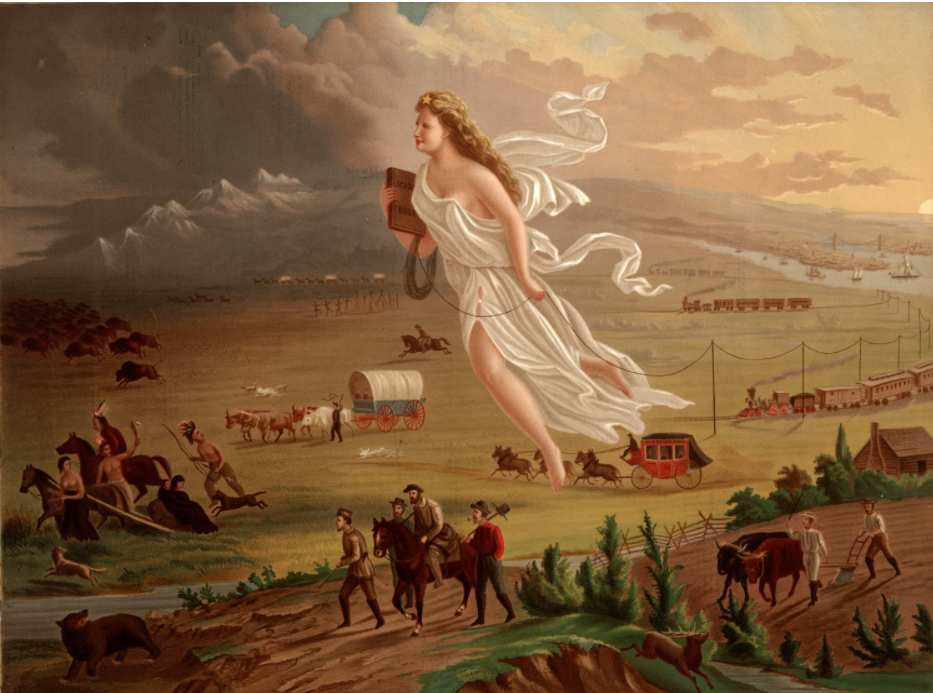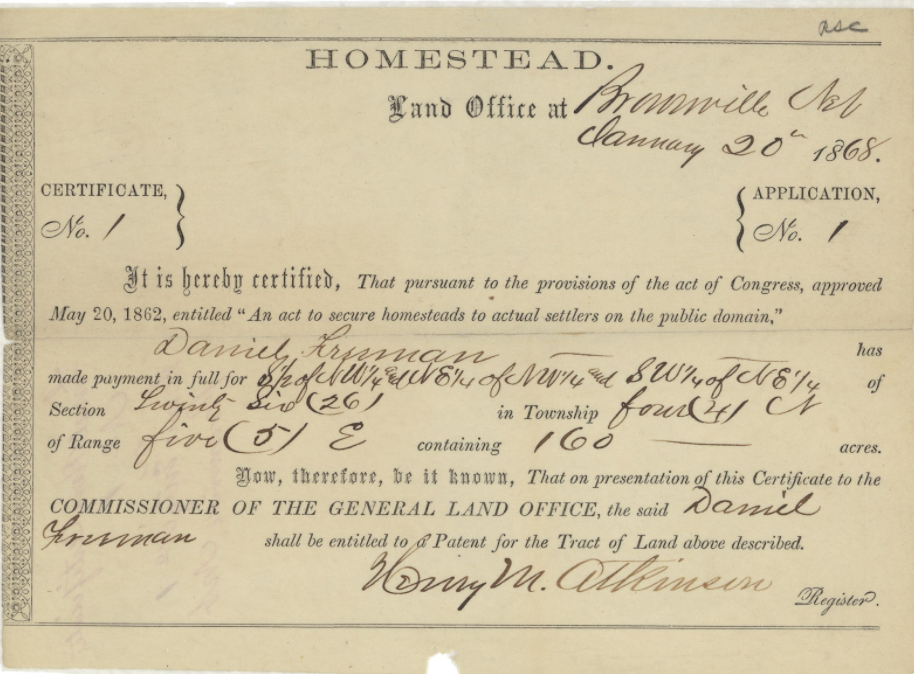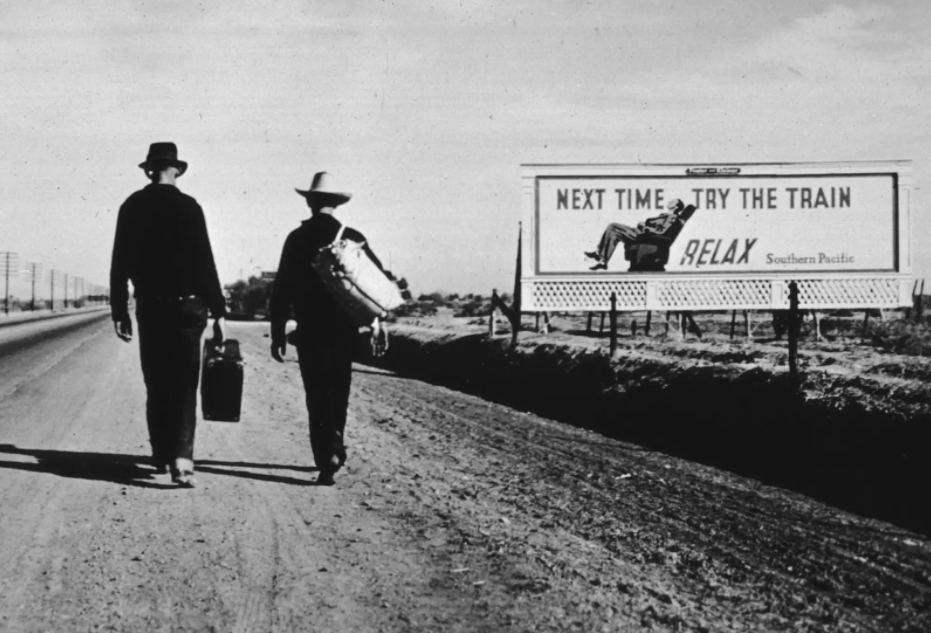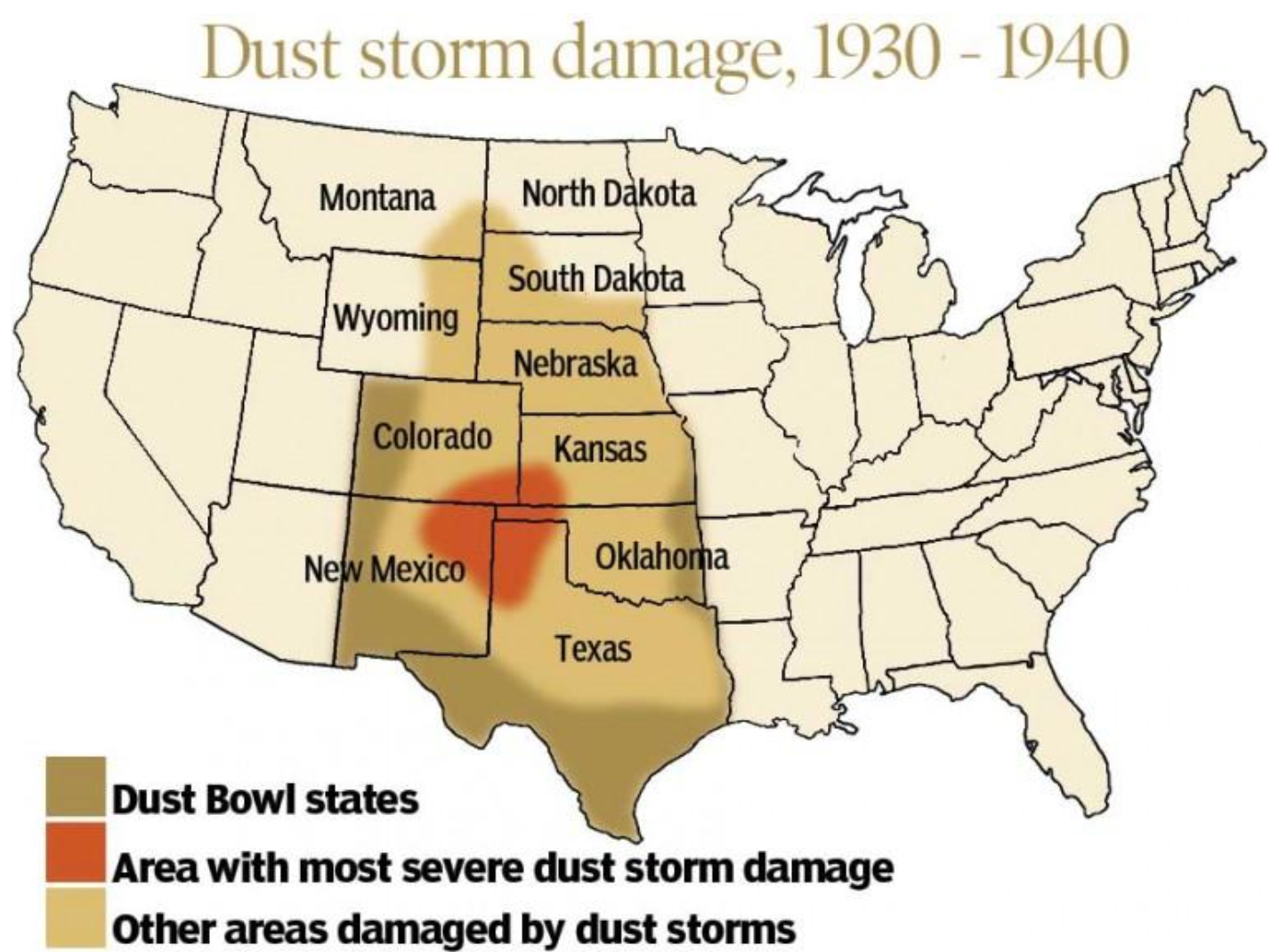What happened?
- Several social factors exacerbated the impact of the drought known as the Dust Bowl in the Great Plains region of the United States during the 1930s:
- Manifest Destiny: Manifest Destiny, a phrase coined in 1845, was the belief that white Americans were called by God to expand the United States and spread democracy and capitalism across North America. This belief drove much of the US territorial expansion during the 19th century and led to a large influx of inexperienced farmers who engaged in poor land management practices to the Great Plains.

American Progress (1872) by John Gast. This painting symbolizes the belief of Manifest Destiny. Columbia, the female figure of America, leads Americans into the West. She is carrying the values of republicanism, as shown by her Roman garb, and progress, as shown by technological innovations like the telegraph and trains. In front of her, Indigenous Peoples and animals are forced into the darkness.
-
- The Homestead Act of 1862: During the American Civil War, a series of federal acts encouraged people to move west. One such act was the Homestead Act, which provided settlers with 160 acres of public land, most of which was west of the Mississippi River, on the condition that they would improve and farm it. 10% of the area in the United States was claimed and settled under this act, which also contributed to inexperienced farmers flocking to the Great Plains region.

The homestead certificate of Daniel Freeman, the first American to file a homestead claim for land under the Homestead Act of 1862 (from The National Archives, n.d.).
-
- “Rain Follows the Plow”: Many people believed that establishing farming would bring about a permanent increase in rainfall. An unusually wet period in the Great Plains during the first half of the 19th century helped perpetuate this belief, creating further misunderstanding of the region’s climate and ecology and encouraging more people to take up unsustainable agricultural practices.
- Rising prices of wheat from Europe: An increase in the prices of wheat imported from Europe before and during World War I (1914-1918) encouraged farmers to plow up native grasslands and plant wheat in the Great Plains. This was extremely detrimental to the land, as it created a layer of loose topsoil that could be easily eroded.
- The Great Depression: The Great Depression was a severe worldwide economic crisis that began with the stock market crash in 1929. Wheat prices in the United States plummeted, so farmers in the Great Plains had to plow up more grassland and plant more wheat just to make a profit. This further contributed to the environmental degradation brought on by the Dust Bowl.

Two men who became unemployed in the Great Depression walking towards Los Angeles, California in search of work (from Amadeo, 2021).
- The Dust Bowl caused social and economic consequences beyond just the Great Plains:
- The Okie Migration: Throughout the 1930s, 2.5 million people fled the Dust Bowl states (map below). Most traveled west, especially to California, looking for work in one of the largest migrations in United States history. The people who migrated, called “Okies” regardless of whether or not they were from Oklahoma, had lost everything, so most were poor. They faced discrimination, menial labor and poor wages in the places they moved to. Without a workforce, the economies of the states they left behind were completely devastated. The Grapes of Wrath (1939) by John Steinbeck tells the story of the Joad family, who flee Oklahoma during the Dust Bowl.
- The New Deal: The New Deal was a series of economic and social programs and projects enacted by President Franklin D. Roosevelt between 1933 and 1939 to rescue the United States from the Great Depression. Several such programs included the Soil Erosion Service, which is now known as the Natural Resources Conservation Service (NRCS), and the Prairie States Forestry Project, both established in 1935. These projects planted windbreaks, or swaths of trees that protect soil and crops from wind, to restore the grassland destroyed by the Dust Bowl.
How is this related to climate?
- The Dust Bowl was one of the worst droughts and perhaps the worst and most prolonged disaster in United States history. It affected Kansas, Oklahoma, Texas, New Mexico and Colorado, known as the Dust Bowl states, as well as parts of other surrounding states (map below), covering a total of 100 million acres.

A map of the United States showing the area affected by the Dust Bowl (from Moore, 2020).
- The Great Plains, a flat expanse of land east of the Rocky Mountains, are prone to dust and sand storms during periods of drought because air flows down the side of the mountains and rushes across the plains, creating high winds. The most severe dust storms were called “black blizzards.”
- There were 14 dust storms in 1932 and 38 in 1933. Some carried topsoil from the Great Plains all the way to Washington DC and New York City.
- The worst dust storm occurred on April 14, 1935, a day that was nicknamed “Black Sunday.”
- When a dust storm hit, drifts of dirt buried pastures and barnyards, piled up at doors, came through window cracks and sifted down from ceilings. Static charges in the air shorted-out automobiles on the road. Children had to wear dust masks while walking to school. It is estimated that 7,000 people died from “dust pneumonia,” or from inhaling dust in the air.
- The Great Plains region of the United States has a naturally dry climate. It is categorized as a semi-arid or steppe climate, which is the next driest climate category to deserts, and receives less than 50 cm of rainfall per year. However, the 1930s was an exceptionally dry period. Several reasons for this have been proposed:
- Precipitation in the Great Plains is sensitive to global sea surface temperatures (SSTs), which were highly variable during the 1930s.
- The drop in rainfall was triggered by random atmospheric variability between 1932 and 1939.
- Regular rainfall returned to the region by the end of 1939, bringing the Dust Bowl to a close.
References and additional resources
- “About the Homestead Act.” National Park Service. n.d. https://www.nps.gov/home/learn/historyculture/abouthomesteadactlaw.htm.
- Amadeo, K. “Great Depression Pictures.” ThoughtCo. 2021. https://www.thoughtco.com/photos-of-the-great-depression-4061803.
- History.com Editors. “Dust Bowl.” History. 2009. https://www.history.com/topics/great-depression/dust-bowl.
- History.com Editors. “Manifest Destiny.” History. 2010. https://www.history.com/topics/westward-expansion/manifest-destiny#section_3.
- “Manifest Destiny Painting, 1872.” The American Yawp Reader. n.d. http://www.americanyawp.com/reader/manifest-destiny-2/.
- Moore, G. “Black Blizzards.” The Friday Footnote. 2020. https://footnote.wordpress.ncsu.edu/2020/07/23/black-blizzards-7-24-2020/.
- Oblack, R. “The 1930’s Dust Bowl Drought.” ThoughtCo. 2019. https://www.thoughtco.com/1930s-dust-bowl-drought-3444382.
- The Editors of Encyclopedia Britannica. “Dust Bowl.” Encyclopedia Britannica. 1998. https://www.britannica.com/place/Dust-Bowl.
- “The Homestead Act of 1862.” The National Archives. n.d. https://www.archives.gov/education/lessons/homestead-act.
